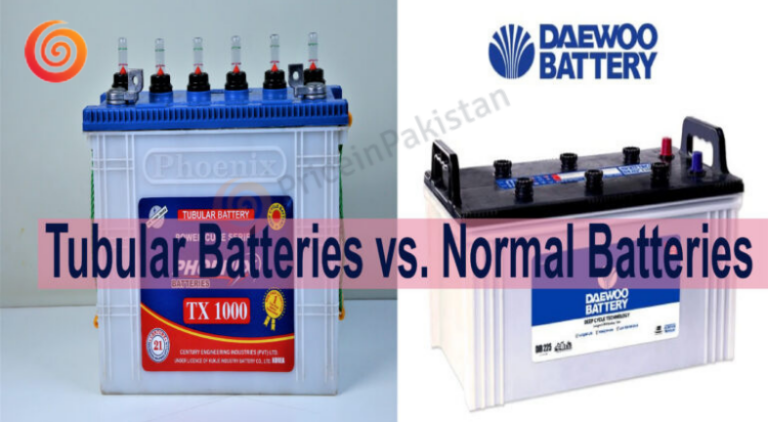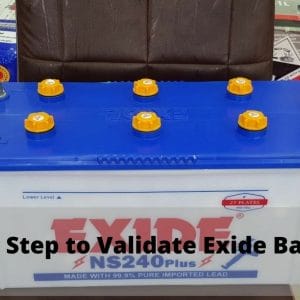Table of Contents
Tubular batteries vs Normal batteries
If you are going to purchase the inverter battery, you might wonder what is the difference between Tubular battery and other batteries (normal battery). Also, you might be wondering which one of them is better and which one to choose to connect with the home UPS and inverter.
In this article, we will explain differences and compare Tubular vs normal batteries so that you can make a more suitable choice for yourself.
What is the Lead Acid Battery?
All the rechargeable inverter batteries are the lead acid batteries. They have two electrodes; lead and lead dioxide electrodes, dipped in the Sulfuric acid electrolyte solution. The two electrodes dipped in electrolyte cause chemical reactions which generate DC current. The chemical reactions are reversible which makes them rechargeable.
Types of Lead Acid Batteries
Tubular battery is basically a type of Lead acid battery. The lead acid batteries may differ in types, models or brands but their basic mechanism remains the same. Lead acid batteries have two major types;
- Tubular battery
- Flat plate battery
This might be a little surprising for many of you as we often think that the flat plate battery is one and the same as the lead acid battery, which is quite wrong. When people ask tubular battery vs lead acid battery, they actually mean asking tubular battery vs flat plate battery.
Tubular and flat plate batteries have minor differences but these differences have a huge impact on the efficiency, lifespan, weight and price of the battery.
Tubular Vs Flat Plate Batteries
The major difference between tubular and flat plate batteries is the positive plate. The positive plate is an important component of the batteries and decays over time. The tubular batteries have a tube made of cloth and coated instead of a positive plate hence the name tubular battery.
The tube slows down the decay process and, in turn, increases the lifespan of the battery. It also requires less maintenance and distilled water toppings. See the table below to find the differences between tubular and flat plate batteries.
| Feature | Tubular Battery | Flat Plate Battery |
| Battery Lifespan | About 5 years | About 3 years |
| Electrodes | Positive tube and negative plate | Positive plate and negative plate |
| Safety | Low | Low |
| Efficiency | High efficiency. Less wastage of current hence less electricity bills in long term. | Low efficiency. High wastage of current which increases the electricity bills. |
| Maintenance | Low | High |
| Water toppings | Low | High |
| Ventilation Requirement | Yes | Yes |
| Releases harmful gases | Yes | Yes |
| Weight | High | Low |
| Best Brands | Exide, Phoenix, Inverex, Safe | Daewoo, Exide, Homage, Bridge Power, Fujika |
| Price Range | PKR 20,000 to PKR 30,000 | PKR 15,000 to PKR 25,000 |
How to Choose a Battery for Home?
Do you want to have a continuous supply of electricity despite numerous power cuts and extreme weather? An inverter and a durable and effective inverter battery are the best options for you. A battery is an important component of an inverter on which its output and life depend.
Before buying an inverter battery, you should calculate your power requirement. Your power backup requirement is determined by two important factors on the basis of which you should decide the suitable capacity according to your need.
- Duration of continuous power backup; for how long there is no electricity at your home.
- Appliances you want to run on the battery when the power fails.
By calculating this time and load, you will get an ampere-hour (Ah) rating of the inverter battery. You will have to decide the required battery capacity on the basis of these two factors.
Flat Plate Battery:
Flat plate battery is a lead-acid battery. It is suitable for areas with low duration but frequent power cuts.
These types of batteries are more inexpensive but have a shorter life than tubular inverter batteries. These batteries have a faster charging rate and require less time to charge but have a shorter warranty than tubular batteries.
Tubular Battery
Tubular battery is also a lead-acid battery. It is bigger in size than the flat plate battery. These inverter batteries are recommended for areas with longer but fewer power failures.
They are more suitable for long power backup requirements and have a long service life. They require less maintenance and water top-ups. They are durable and more reliable and have a longer warranty than flat plate batteries. However, a tubular battery is bigger in size and is more expensive than a flat plate battery.
Tubular batteries are available in different container sizes. You will have to pick the size according to the space available to store it in the house. These batteries have two types; short tubular and tall tubular batteries.
Short Tubular Battery
Short tubular inverter battery is a bit shorter in height but it is wider than a tall tubular battery which makes it easier to carry and store them.
Tall Tubular Battery
Tall tubular inverter battery is bigger in height but lesser in width than a short tubular battery and a flat plate battery.
It has a slightly longer backup time and is ideal for homes where storage space is not a problem.
Gel Batteries
They provide a more consistent power backup for a longer period than any type of lead-acid battery.
It comes with a special criss cross structure of gel-like mass that holds the acid and keeps it from settling down. These types of batteries also offer more power backup per cycle.
Gel batteries are more expensive than tubular lead acid batteries. The biggest advantage of a gel battery is that it emits minimal harmful gas which makes it environment friendly.
Its leak-free case ensures zero acid spillage. It is easy to install and maintain and does not require regular water top-up.
Gel batteries provide consistent power backup throughout their lives unlike normal batteries where power backup decreases over the years.
Factors to Consider While Buying an Inverter Battery?
The main factors you need to consider while buying a battery are its capacity, technology used, size and warranty.
The ideal inverter battery will have the highest Ah rating and warranty. Technology used should be such that it suits your requirements and provides stable power backup. The physical size of the battery should be according to the storage space at your home.
Make sure you buy an inverter battery from a renowned brand instead of a local manufacturer so that you get good product and service.
Also, consider the freshness of a new inverter battery as the performance of a battery decreases if it is not in use for a long period. Check the manufacturing date on the battery label before buying it.
Maintenance and Handling of a Battery
- Avoid storing the battery in direct sunlight.
- Keep the battery away from children.
- Store it in a cool, dry and ventilated space.
- Avoid filling acid into the battery.
- Monitor the float indicators in the battery from time to time and add water top-up when needed.
- Avoid keeping the battery water indicators open.
- Prefer authorized service personnel for maintenance.
- Do not throw away non-functional batteries into dustbins, streets, garbage piles or elsewhere.
- Retire old and non-functional inverter batteries by returning them to an authorized distributor for recycling.

Hamza Subhan is a digital content director at Price In Pakistan. He lives in Lahore. He keeps an eye on every new item in the markets of Pakistan and his hand on the pulse of Pakistani people to provide them with the information that they need about the product. He has a bachelor’s degree in Electrical engineering from UET Lahore. His keen passion for the latest technology, gadgets, and knowledge about electrical appliances led him to launch Price In Pakistan. He is the main hand behind the articles related to electrical home appliances and gadgets. When he is not looking out for the new technology and writing about it, he is playing guitar and singing for his friends.






